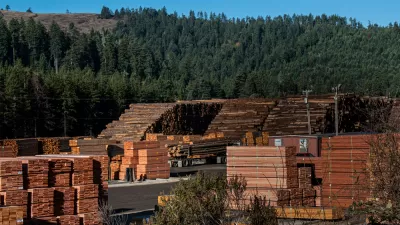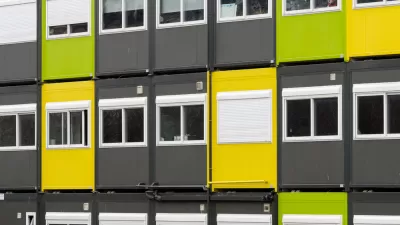With demand soaring and materials in short supply, the cost of building a home has risen sharply in the last year.

With prices for construction materials soaring during the pandemic, write Marcy Nicholson, Dave Merrill, and Cedric Sam for Bloomberg, building a home is more expensive than ever. "There are any number of factors at play—from rock-bottom mortgage rates to city dwellers’ rush to the suburbs to shortages of materials—but the simplest explanation is that there is just too much demand for builders and their suppliers to handle. All of this makes housing an extreme manifestation of the inflationary pressures percolating through the booming U.S. economy."
Costs for some materials, like concrete, were already rising sharply before the pandemic hit. Lumber, "the biggest pain point by far," has jumped in price by as much as 400%. "It’s not just the two-by-fours that go into the framing. Builders are paying up and waiting longer for oriented strand board (OSB), a lower-cost stand-in for plywood. The price of these panels soared to a rare premium over plywood in October, and they’ve since been in short supply." As builders struggle to make up the increases, "buyers are on the hook for the higher costs," and "[w]ith raw materials prices continuing to surge around the world, the pressure on builders to increase costs is likely to grow stronger."
"This could be industry killing," worries Steve Martinez, the owner of a construction business in Boise, Idaho. The final cost of one of his home models, the Baybrook, has risen 61% from 2019.
FULL STORY: Building a Home in the U.S. Has Never Been More Expensive

Planetizen Federal Action Tracker
A weekly monitor of how Trump’s orders and actions are impacting planners and planning in America.

Map: Where Senate Republicans Want to Sell Your Public Lands
For public land advocates, the Senate Republicans’ proposal to sell millions of acres of public land in the West is “the biggest fight of their careers.”

Restaurant Patios Were a Pandemic Win — Why Were They so Hard to Keep?
Social distancing requirements and changes in travel patterns prompted cities to pilot new uses for street and sidewalk space. Then it got complicated.

Platform Pilsner: Vancouver Transit Agency Releases... a Beer?
TransLink will receive a portion of every sale of the four-pack.

Toronto Weighs Cheaper Transit, Parking Hikes for Major Events
Special event rates would take effect during large festivals, sports games and concerts to ‘discourage driving, manage congestion and free up space for transit.”

Berlin to Consider Car-Free Zone Larger Than Manhattan
The area bound by the 22-mile Ringbahn would still allow 12 uses of a private automobile per year per person, and several other exemptions.
Urban Design for Planners 1: Software Tools
This six-course series explores essential urban design concepts using open source software and equips planners with the tools they need to participate fully in the urban design process.
Planning for Universal Design
Learn the tools for implementing Universal Design in planning regulations.
Heyer Gruel & Associates PA
JM Goldson LLC
Custer County Colorado
City of Camden Redevelopment Agency
City of Astoria
Transportation Research & Education Center (TREC) at Portland State University
Camden Redevelopment Agency
City of Claremont
Municipality of Princeton (NJ)





























